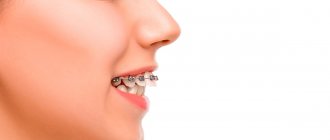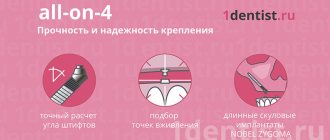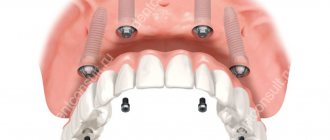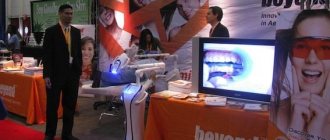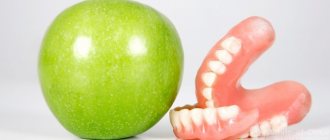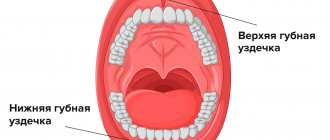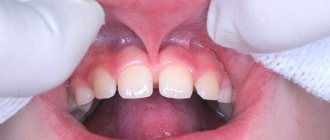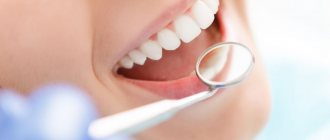This article is devoted to the problem increasing/decreasing the chin protrusion. If you are interested in the question of how to remove a double chin, go to the article “ HOW TO REMOVE A SECOND CHIN“.
Plastic surgery methods (genioplasty or mentoplasty) are used to reduce or enlarge the chin. Chin surgery can help you not only change the size of your chin bump, but also improve its shape. As a result of this operation, you will get a more proportional and beautiful face.
All photos
CHIN PLASTY – ANTI-AGING EFFECT
After chin augmentation surgery, almost all patients note that their face looks not only more beautiful, but also younger. Everything is very simple! The increased size of the chin protuberance compensates for the missing volume of subcutaneous tissue, thanks to which all folds of the skin are straightened, jowls and wrinkles disappear, and the skin under the chin is tightened. But it is also prevention. Let's reveal a secret - people with a small (sloping) chin age earlier and more noticeably.
Chin plastic surgery (especially augmentation mentoplasty) is popular not only among women, but also among men. After all, it’s hard to imagine a man’s face without a beautiful, strong-willed chin.
Chin surgery is often performed simultaneously with rhinoplasty. If a small chin is adjacent to a large nose (the “parrot profile” effect) or the patient does not like the predatory profile with a hooked nose and a protruding chin, a comprehensive correction can be performed. This operation is called profiloplasty. We write about complex chin and nose surgery here.
Chin augmentation can be performed either with or without an implant (due to rotation of the bony protrusion of the chin). And, of course, Dr. Kudinova can not only enlarge, but also (which is much more difficult!) reduce your chin.
Kudinova Ekaterina Sergeevna
Candidate of Medical Sciences, certificates in plastic and maxillofacial surgery. International expert in face and neck lifts, eyelid surgery, eyebrow surgery, chin surgery, etc.
To learn more
The child does not sleep well at night, the child grinds his teeth (bruxism): a behavioral feature or a disease?
Getting a full night and daytime sleep every day is a very important condition for the development of mental functions of a preschool child. If your child begins to have trouble falling asleep and wakes up frequently, you should take this as carefully as possible. We are engaged in restoring normal sleep in children. Correction or treatment depends on the causes of sleep difficulties and is determined during a consultation or after a scheduled examination, if necessary.
How long should a child sleep?
| Child's age | Daytime sleep duration | Night sleep duration |
| 1 to 2 months | about 9 o'clock | around 18 o'clock |
| 3 to 4 months | about 8-6 hours | about 16 o'clock |
| 7 to 9 months | about 4 hours | about 13 o'clock |
| 10 to 12 months | about 3 hours | about 13 o'clock |
| From 1 to 1.5 years | about 3 hours | about 12 hours |
| From 1.5 to 2 years | about 2.5 hours | around 10-11 o'clock |
| From 2 to 3 years | about 2.5 – 2 hours | around 10-11 o'clock |
| From 3 to 7 years | about 1.5 hours, optional | about 10 o'clock |
| After 7 years | Daytime naps are not necessary | at least 8-9 hours |
Sleeping mode
. A child's normal sleep should proceed without interruption, without episodes of agitation associated with screaming or crying during sleep. The normal duration of falling asleep is about half an hour; if it lasts more than 30 minutes, you should pay attention to this and find out the reason. It is normal for a child to wake up early on weekends according to the routine adopted on weekdays. It is desirable that the biorhythm of the child’s life coincides with the biorhythm of the geographical time zone in which he lives. It is provided in nature that when it is dark outside, a person sleeps, and at dawn he wakes up, the same rhythm corresponds to the children's regime. For a preschooler, lights out should be no later than 10 p.m. It is not always possible for schoolchildren to maintain such a regime, because the load received at school increases disproportionately to the physiological capabilities of the children. But still, for the harmonious growth and development of a child, it is necessary to strive to adhere to the regime and have at least 8-9 hours of sleep. For a child under 10 years old, a sleep duration of 9-10 hours is absolutely normal and healthy.
Many children approaching school age refuse to sleep during the day; this is not always a violation of their sleep patterns; for some children, with a full night's sleep, the need for daytime sleep disappears. Provided that the lack of daytime sleep does not entail a change in the child’s well-being for the worse. One more aspect must be taken into account that for children under 4 years of age, daytime sleep is vital, since during this period of life the neural structure of the brain is actively being built and good sleep contributes to the most efficient functioning of the brain in the future.
Sleep consists of several stages (divided into phases). Complete rest, restoration of the nervous system, active metabolism and immunity occur mainly in the third and fourth phases of sleep. These phases are achieved only in night sleep, subject to timely falling asleep, sufficient duration and depth of sleep, and the absence of night awakenings.
A situation where a child does not sleep at night or
has difficulty falling asleep for a long time, often gets up, asks for something to drink or eat, or invents different activities for himself just to stay awake, can arise for many reasons.
Main reasons :
- increased intracranial pressure (ICP);
- increased level of anxiety;
- a stressful situation or excessive nervous tension in response to something;
- neurosis;
- excessive workload of the child at school;
- increased convulsive readiness of the cerebral cortex (recorded on the EEG);
- pain in the abdomen or other area of the body, itching, worms.
Behavioral factor.
It arises due to the attention deficit of adults who work all day and come home late, without devoting enough time to their child. As a result, the child falls asleep for a long time, because he wants to make up for the lack of communication with his parents and feel their physical and emotional presence next to him.
High level of anxiety in a child.
When a child cannot fall asleep, but having difficulty falling asleep, he often wakes up or sleeps shallowly, as the stress mechanisms of the nervous system continue to work, including defensive reactions and not allowing the child to fall asleep deeply.
The child screams in his sleep, walks, talks in his sleep.
Sleepwalking (somnambulism) is a state of incomplete awakening. At the time when the child should enter the deep stage of sleep, the process of brain inhibition occurs, but the process does not affect all areas of the brain, i.e. part of the brain remains awake or wakes up in the middle of the night. As a result, the child can sit up in bed, stand up, walk, scream, express emotions and even talk without waking up. Sleepwalking in children is usually quite treatable.
The child grinds his teeth in his sleep
. The main age when bruxism occurs is the period from 3 to 6 years. The peak of manifestation occurs at the age of five, when molars begin to erupt. The cause of teeth grinding can be difficulty breathing due to adenoids, ear or toothache and nasal congestion, abdominal pain and, in general, any physical discomfort.
Lack of adequate sleep can lead to serious problems for a child’s body. Such as a disorder of the nervous system, weakening of the immune system, disruption of the body’s usual mode of operation of all internal organs. It is necessary to treat your child's sleep as carefully as possible. Restoring normal night sleep in a child is, as a rule, a completely doable task.
treating a child who is not sleeping well first.
:
- Consultation with a pediatric neurologist. Typically, during the consultation, the cause of the sleep disorder will be clarified and treatment can be selected.
- If there are suspicions about chronic night pain anywhere, skin itching, nasal breathing problems, we will offer help from a doctor of the appropriate profile.
IS CHIN PLASTY RIGHT FOR ME?
Indications for chin correction surgery may include:
- An underdeveloped, sloping chin, creating the effect of a small “bird” face;
- A small chin and age-related changes, as a result of which soft tissues slide down, forming “jowls” and a double chin;
- Too large, protruding chin;
- Wide, heavy lower jaw (“horse-like” face);
- Unattractive or asymmetrical chin shape.
To obtain a comprehensive result, chin surgery can be combined with liposuction and neck lift, as well as rhinoplasty.
Results Before and After CHIN PLASTY View now
Hyperactive child and restless child. Increased excitability in a child
Symptoms and causes.
A hyperactive child cannot sit for a long time and do work associated with a static body position, often screams loudly and violently expresses emotions, has an attention deficit that does not allow him to concentrate on one thing, and is forced to discharge accumulated tension through physical activity.
That is, in the child’s nervous system, excitation significantly dominates over inhibition. The danger of increased excitability is a decrease in learning ability and, as a result, a child falling behind his peers in development.
It is important to understand the source of increased excitability and restlessness.
Therefore, the first thing we will offer you is to find out the reason for what is happening. There are three main options:
- This is your child’s normal natural temperament
and the intervention of a psychiatrist or doctor is not required. The child is mentally healthy and psychologically well-being. In this case, we will give you some recommendations, and you and your child will become noticeably more comfortable. - There is some psychological problem
that increases the child’s level of emotions, anxiety or aggression, for example.
Emotion requires release (discharge, realization), hence increased excitability and restlessness. The child is mentally healthy and does not need any medical treatment.
These kinds of psychological problems are quite easily diagnosed during a conversation with the child and parents, and then gently corrected. - Increased excitability and restlessness are a consequence of a medical problem.
We can talk about, for example, increased intracranial pressure, chronic inflammation somewhere (adenoids, tonsils), neuroinflammation, the consequences of birth hypoxia or trauma, childhood neurosis, a latent form of epilepsy. We also encounter more serious problems in our practice, such as autistic disorder and childhood schizophrenia. In this case, it is very important to find the true cause of what is happening, and only then will the treatment work effectively and safely.
Hyperexcitability, restlessness and hyperactivity as character traits
. If we talk about increased excitability and restlessness as characterological characteristics, this is possible if the child is extroverted and temperamental by nature. Or the child may copy this style of behavior from one of the family members. But we can talk about the norm only if this type of hyperactivity does not lead to health problems and if the child is not so excited that he stops sleeping normally, begins to get sick often, or lags behind in general development. Having severe disinhibition and excitability, the child cannot concentrate and master the skills that he is supposed to master by age.
Hyperactivity test
Active attention deficit:
1.Cannot concentrate on one thing, it is difficult to maintain attention;2.May forget what he was assigned or asked for;3.Likes to start a new activity, but cannot finish it;4.Cannot organize clearly his activities and maintain a routine; 5. It is difficult to maintain order, he may lose all his things; 6. Does not like monotonous tasks that require mental effort and attention; 7. May forget what he was assigned or asked for; 6. Doesn't respond immediately when approached.
Motor disinhibition:
1. Often moves restlessly (runs, jumps, climbs somewhere, fidgets in a chair and at the table); 2. Takes a long time to fall asleep and sleeps poorly, may wake up often4. Likes to talk a lot and uncontrollably.
Impulsiveness:
1. Poor control of one’s behavior; 2. Can’t regulate one’s actions and most often does not follow rules; 3. Poorly concentrates attention; 4. Can’t wait for something to finish or reward; 5. No precise line of behavior, strong variability in results and states; 6. May begin to answer without listening to the question; 7. Often interferes in someone else’s conversation and interrupts it; 8. Doesn't know how to wait, can run without waiting for the start.
If you find at least six of the listed signs in a child under the age of 7, we can assume that there is a tendency to hyperactivity. But only a specialist can make an accurate diagnosis. Where to start and who to contact with an overly excitable child?
If we are talking about a hyperactive, excitable and restless child, then it all starts with a detailed identification of the reason for what caused the child’s nervous system to remain in a state of excitement for such a long time. Most often in such cases, we recommend starting with an appointment with a pediatric neurologist and/or a child psychiatrist, and we also suggest getting a joint appointment with these two experts. This makes it easier and faster to determine the cause of increased excitability, to avoid treatment that is unnecessary in many cases, or to select exactly the treatment that your child needs. Based on the results of the initial examination, we can recommend additional laboratory and instrumental studies. We can also save you time and send a laboratory examination form to your email address for your initial appointment; to do this, you can fill out the “ask a doctor a question” form
.
CHIN PLASTY. METHODS
The following techniques are most often used for surgical correction of the chin:
Chin augmentation with modern implants . This low-traumatic method is indicated for patients with a small, underdeveloped chin who want to achieve more harmonious facial proportions with a clear lower jaw line.
Chin augmentation with your own bone tissue . Small chin augmentation, in which the surgeon moves part of the mental protuberance forward through an osteotomy. This plastic method is used to correct a sloping chin in both men and women.
Chin reduction (reduction mentoplasty) . Correction of a heavy chin, in which the surgeon works with the bone tissue, achieving the desired proportions. Reducing a long chin immediately changes the face, making it graceful and harmonious.
Alternative (non-surgical) methods are chin contouring with natural hyaluronic acid fillers or lipofilling. These methods are indicated if a slight increase in the chin or minor correction of its shape is required.
The choice of chin plastic surgery technique is carried out after a thorough study of the proportions of the face from various angles and other studies.
What are implants made of?
In addition to silicone implants, there are also bioprostheses (based on the patient’s cartilage tissue). Despite the fact that they are as safe as silicone, and therefore are also often used to enlarge the chin, experts note some nuances that can sometimes arise when using them.
“Of course, silicone implants are ideal for chin augmentation, because they do not affect the resorption of bone tissue,” notes Elena Chirikova.
— Silicone elastomer is a semi-soft material, and when changing such an implant, we see the absence of any resorption in the area of the bony part of the chin. If the implant is made of a hard material (for example, a rib), then the bone part of the chin experiences severe pressure from the bioimplant, which forces it to follow the contour of its posterior (facing the bone) part, and the bone part of the chin is resorbed, that is, it loses its own volume.”
HOW IS THE OPERATION FOR SURGICAL CORRECTION OF THE CHIN PERFORMED?
When planning the operation, a thorough comparative analysis of the facial proportions and a comparison of the right and left profiles is carried out. Such an assessment is necessary to ensure that the face after chin surgery looks natural and beautiful from any angle. Then the necessary tests and studies are carried out, including a lateral teleroentgenogram and an orthopantomogram.
Mentoplasty, the price of which varies depending on the chosen surgical technique, is one of the most effective plastic surgery technologies.
Before and After FACE LIFT Results View now
All chin surgeries are performed under general anesthesia and are therefore painless. When performing chin correction surgery, the incision is made in the mouth, in the crease between the lower jaw and lip, so the scar after the operation will not be visible. Chin correction surgery usually takes about 1 hour, but in complex cases, mentoplasty can take longer. If genioplasty is performed in conjunction with other plastic surgeries, such as a facelift or rhinoplasty, the duration of the operation increases to 2-3 hours.
Treatment of skin diseases in children
Since childhood skin diseases occur under the influence of various factors, if a rash appears in a child, visit a dermatologist, he will prescribe tests to identify the causes of the pathology.
To combat dermatosis, drugs are used against the main causative agents of the disease, external agents and tablets are used, the action of which is aimed at eliminating unpleasant manifestations and strengthening the immune system. Physiotherapy - UHF, ultraviolet irradiation, laser therapy - is used as additional treatment methods.
Therapy is carried out at home; in case of chronic skin diseases, children are given vouchers to specialized sanatoriums.
How to treat skin diseases
| Name of the drug | Which group does it belong to? | What is it prescribed for? |
| Viferon, Panavir | Antiviral | For dermatoses of viral origin. |
| Acyclovir | Antiherpes remedy | For infections caused by various types of herpes virus. |
| Collomak, Feresol | Cauterizing agents | Helps remove warts. |
| Lamisil, Ketoconazole, Fluconazole, Nizoral shampoo, Dermazole | Antifungal drugs | For mycoses, seborrhea. |
| Tetracycline, Erythromycin | Antibiotics | For purulent lesions, secondary infections due to scratching of the rash. |
| Medifox, Benzyl benzoate, sulfur ointment | Acaricidal drugs | For scabies. |
| Pediculen Ultra, Nyx | Anti-pediculosis drugs | For pediculosis. |
| Trichopolum, Metronidazole | Antiprotozoal agents | With demodicosis |
| Zyrtec, Cetrin | Antihistamines | Prescribed for all types of dermatoses to eliminate itching and swelling. |
| Prednisolone, Diprospan, Hydrocortisone ointment, Lorinden | Glucocorticosteroids | Eliminates severe inflammatory processes and unbearable itching in severe forms of skin diseases. |
| Polysorb, activated carbon | Enterosorbents | They remove toxins and allergens from the body and are necessary for all types of skin diseases. |
| Ibuprofen, paracetamol | Antipyretic | Reduces temperature in infectious diseases. |
| Immunal, Polyoxidonium | Immunomodulators | They strengthen the immune system; medications are necessary for all types of dermatoses. |
| Bepanten | External emollients | For severe peeling of the skin. |
| Miramistin, Fukortsin | Antiseptics | For lubricating rashes due to dermatoses. |
| Tenoten, Pantogam | Sedatives | For nervous disorders. |
If the rash occurs against the background of diseases of the kidneys, liver, blood, or digestive system, it is necessary to eliminate the underlying disease.
REHABILITATION AFTER CHIN PLASTY
After the operation, the patient remains in the clinic until the next morning. The chin area is fixed with a special “invisible” plaster (without using a bandage).
Rehabilitation after chin correction takes up to 14 days. At this time, it is necessary to carefully observe a gentle regimen, avoid intense physical activity, and avoid sudden head movements.
In the first days after surgery, patients may experience swelling of the chin and discomfort in the suture area. To reduce unwanted effects and speed up healing, the doctor prescribes special medications, and physical therapy may be prescribed.
Lipolytic mesotherapy
Intradermal administration of lipolytic meso-cocktails is one of the modern minimally invasive methods for eliminating a double chin. To achieve the desired result, it is necessary to perform several procedures with an interval of 8-10 days.
There are two types of meso-cocktails for injection lipolysis:
- liporeducers - help reduce the volume of fat cells;
- true lipolytics - they destroy fat cells into components that are excreted through the lymph flow.
Advantages and disadvantages of the method
- Thanks to lipolytic mesotherapy, the volume of fat depot in the submandibular area can be significantly reduced.
- All manipulations are performed on an outpatient basis.
- The results of injection lipolysis last for a long time (at least a year).
- Injection of lipolytic mesococktails has no specific side effects or complications.
Unfortunately, it is not always possible to effectively eliminate a double chin using this technique. If there is a large amount of sagging skin that has lost its elasticity (for example, as a result of gravitational ptosis), the use of lipolytic mesotherapy is not advisable.
How is lipolytic mesotherapy for the double chin performed?
- First, cleansing and antiseptic treatment of the correction area is performed. If necessary (low pain threshold), an anesthetic is applied.
- Then a series of intradermal injections is performed to evenly distribute the meso-cocktail.
- The procedure is completed with antiseptic treatment and application of a soothing mask or cooling compress.
Contraindications and side effects
Like other types of injection plastic surgery, correction using lipolytic meso-cocktails is not carried out in cases of individual intolerance to individual components or the drug as a whole, the presence of skin and autoimmune pathologies, ARVI, during pregnancy and breastfeeding, during exacerbation of chronic diseases, etc.
With the correct selection of the drug and proper implementation of the procedure, side effects are short-lived and are associated with the technique of administering the mesococktail:
- during the first 2-3 days after the session, there may be redness, swelling, a burning sensation in the correction area, a feeling of fullness at the points where the needle was inserted;
- Within a week, bruising from the injections may be noticeable.
Preparation and rehabilitation period
The day before a lipolytic mesotherapy session, it is necessary to stop drinking alcohol, reduce physical activity as much as possible, and also follow the individual recommendations received at a preliminary consultation with a cosmetologist (for example, stop taking certain medications for a while).
- Immediately after completion of the session, in order to distribute the meso-cocktail evenly, you need to rest quietly in a lying position and drink 400-500 ml of water to restore the water-salt balance.
- On the first day after injections of lipolytic meso-cocktails, for faster skin restoration and elimination of possible discomfort, it is recommended to apply cooling compresses to the correction area.
- During the entire course and 2 weeks after its completion, you should not visit the sauna or be in direct sunlight.
To effectively remove fat and preserve the result for a longer period after lipolytic mesotherapy, it is recommended:
- drink at least 2 liters of water daily;
- Take regular walks in the fresh air;
- avoid insolation of the correction zone;
- use sunscreen at any time of the year.
DO YOU NEED THE BEST CHIN PLASTIC SPECIALIST IN MOSCOW?
Plastic and maxillofacial surgeon Ekaterina Sergeevna Kudinova is a candidate of medical sciences, a leading Russian specialist in the field of plastic surgery of the chin, lower jaw and nose.
As a leading researcher at the best Moscow clinical center of otorhinolaryngology, Ekaterina Sergeevna performs complex facial reconstructive surgeries for patients injured in accidents. This unique experience helps her achieve excellent results in relatively simpler aesthetic chin surgery and complex profile correction surgeries.
Delicacy, tact and the ability to empathize allow the doctor to gain trust and find mutual understanding with each patient.
You can make an appointment for a consultation with Ekaterina Sergeevna Kudinova by calling 1 or. You can also leave a request through the online consultation form on the website.
Prevention of childhood skin diseases
It is almost impossible to completely prevent the appearance of rashes on a child’s skin, but following simple rules will help reduce the risk of developing dermatological problems to a minimum.
How to avoid skin diseases:
- timely vaccination – vaccinations protect children from many viral diseases;
- regularly strengthen the immune system - hardening, following a daily routine, proper nutrition, exercise;
- observe the rules of hygiene;
- regularly carry out wet cleaning and ventilate the premises;
- immediately treat all wounds and scratches with antiseptic agents;
- take vitamin complexes twice a year;
- do not give your child antibiotics or other potent drugs without a doctor’s prescription;
- Regularly visit specialized specialists for preventive examinations.
Most skin diseases are contagious, sick children should be protected from communication with healthy ones, and they can only attend school and kindergarten if they have a certificate from a dermatologist.
Every child can develop skin rashes; the parents’ task is to contact a dermatologist in time to identify the cause of the disease, accurately follow all the doctor’s recommendations, keep the room clean, and follow hygiene rules.


